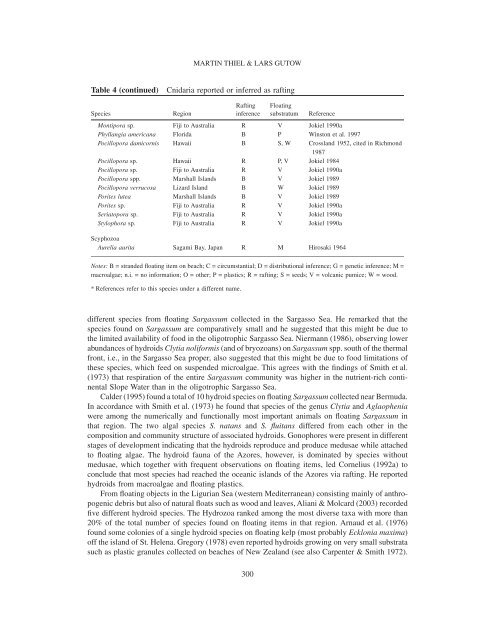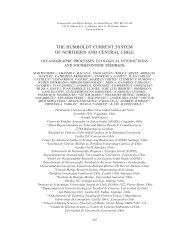The ecology of rafting in the marine environment - Bedim
The ecology of rafting in the marine environment - Bedim
The ecology of rafting in the marine environment - Bedim
Create successful ePaper yourself
Turn your PDF publications into a flip-book with our unique Google optimized e-Paper software.
MARTIN THIEL & LARS GUTOW<br />
Table 4 (cont<strong>in</strong>ued) Cnidaria reported or <strong>in</strong>ferred as <strong>raft<strong>in</strong>g</strong><br />
Species Region<br />
Raft<strong>in</strong>g<br />
<strong>in</strong>ference<br />
different species from float<strong>in</strong>g Sargassum collected <strong>in</strong> <strong>the</strong> Sargasso Sea. He remarked that <strong>the</strong><br />
species found on Sargassum are comparatively small and he suggested that this might be due to<br />
<strong>the</strong> limited availability <strong>of</strong> food <strong>in</strong> <strong>the</strong> oligotrophic Sargasso Sea. Niermann (1986), observ<strong>in</strong>g lower<br />
abundances <strong>of</strong> hydroids Clytia noliformis (and <strong>of</strong> bryozoans) on Sargassum spp. south <strong>of</strong> <strong>the</strong> <strong>the</strong>rmal<br />
front, i.e., <strong>in</strong> <strong>the</strong> Sargasso Sea proper, also suggested that this might be due to food limitations <strong>of</strong><br />
<strong>the</strong>se species, which feed on suspended microalgae. This agrees with <strong>the</strong> f<strong>in</strong>d<strong>in</strong>gs <strong>of</strong> Smith et al.<br />
(1973) that respiration <strong>of</strong> <strong>the</strong> entire Sargassum community was higher <strong>in</strong> <strong>the</strong> nutrient-rich cont<strong>in</strong>ental<br />
Slope Water than <strong>in</strong> <strong>the</strong> oligotrophic Sargasso Sea.<br />
Calder (1995) found a total <strong>of</strong> 10 hydroid species on float<strong>in</strong>g Sargassum collected near Bermuda.<br />
In accordance with Smith et al. (1973) he found that species <strong>of</strong> <strong>the</strong> genus Clytia and Aglaophenia<br />
were among <strong>the</strong> numerically and functionally most important animals on float<strong>in</strong>g Sargassum <strong>in</strong><br />
that region. <strong>The</strong> two algal species S. natans and S. fluitans differed from each o<strong>the</strong>r <strong>in</strong> <strong>the</strong><br />
composition and community structure <strong>of</strong> associated hydroids. Gonophores were present <strong>in</strong> different<br />
stages <strong>of</strong> development <strong>in</strong>dicat<strong>in</strong>g that <strong>the</strong> hydroids reproduce and produce medusae while attached<br />
to float<strong>in</strong>g algae. <strong>The</strong> hydroid fauna <strong>of</strong> <strong>the</strong> Azores, however, is dom<strong>in</strong>ated by species without<br />
medusae, which toge<strong>the</strong>r with frequent observations on float<strong>in</strong>g items, led Cornelius (1992a) to<br />
conclude that most species had reached <strong>the</strong> oceanic islands <strong>of</strong> <strong>the</strong> Azores via <strong>raft<strong>in</strong>g</strong>. He reported<br />
hydroids from macroalgae and float<strong>in</strong>g plastics.<br />
From float<strong>in</strong>g objects <strong>in</strong> <strong>the</strong> Ligurian Sea (western Mediterranean) consist<strong>in</strong>g ma<strong>in</strong>ly <strong>of</strong> anthropogenic<br />
debris but also <strong>of</strong> natural floats such as wood and leaves, Aliani & Molcard (2003) recorded<br />
five different hydroid species. <strong>The</strong> Hydrozoa ranked among <strong>the</strong> most diverse taxa with more than<br />
20% <strong>of</strong> <strong>the</strong> total number <strong>of</strong> species found on float<strong>in</strong>g items <strong>in</strong> that region. Arnaud et al. (1976)<br />
found some colonies <strong>of</strong> a s<strong>in</strong>gle hydroid species on float<strong>in</strong>g kelp (most probably Ecklonia maxima)<br />
<strong>of</strong>f <strong>the</strong> island <strong>of</strong> St. Helena. Gregory (1978) even reported hydroids grow<strong>in</strong>g on very small substrata<br />
such as plastic granules collected on beaches <strong>of</strong> New Zealand (see also Carpenter & Smith 1972).<br />
300<br />
Float<strong>in</strong>g<br />
substratum Reference<br />
Montipora sp. Fiji to Australia R V Jokiel 1990a<br />
Phyllangia americana Florida B P W<strong>in</strong>ston et al. 1997<br />
Pocillopora damicornis Hawaii B S, W Crossland 1952, cited <strong>in</strong> Richmond<br />
1987<br />
Pocillopora sp. Hawaii R P, V Jokiel 1984<br />
Pocillopora sp. Fiji to Australia R V Jokiel 1990a<br />
Pocillopora spp. Marshall Islands B V Jokiel 1989<br />
Pocillopora verrucosa Lizard Island B W Jokiel 1989<br />
Porites lutea Marshall Islands B V Jokiel 1989<br />
Porites sp. Fiji to Australia R V Jokiel 1990a<br />
Seriatopora sp. Fiji to Australia R V Jokiel 1990a<br />
Stylophora sp. Fiji to Australia R V Jokiel 1990a<br />
Scyphozoa<br />
Aurelia aurita Sagami Bay, Japan R M Hirosaki 1964<br />
Notes: B = stranded float<strong>in</strong>g item on beach; C = circumstantial; D = distributional <strong>in</strong>ference; G = genetic <strong>in</strong>ference; M =<br />
macroalgae; n.i. = no <strong>in</strong>formation; O = o<strong>the</strong>r; P = plastics; R = <strong>raft<strong>in</strong>g</strong>; S = seeds; V = volcanic pumice; W = wood.<br />
* References refer to this species under a different name.










